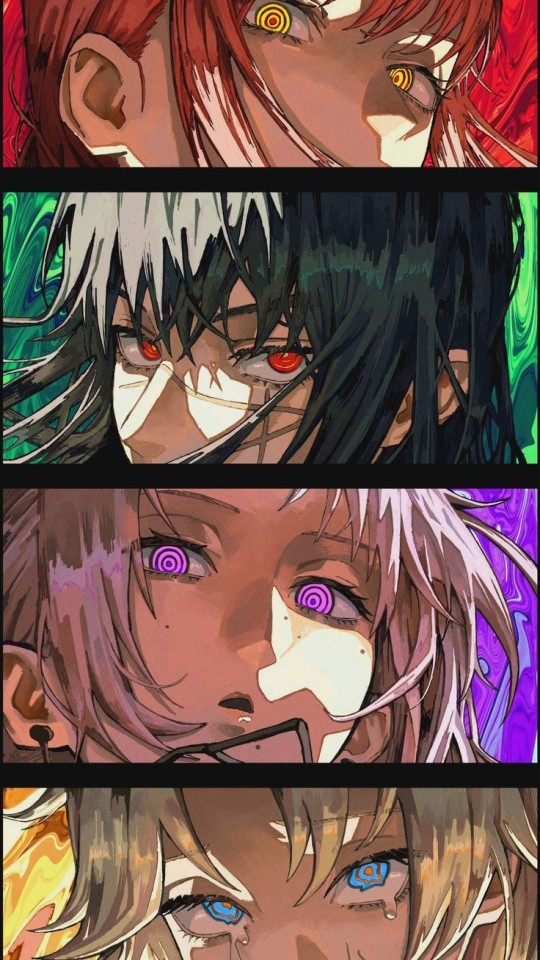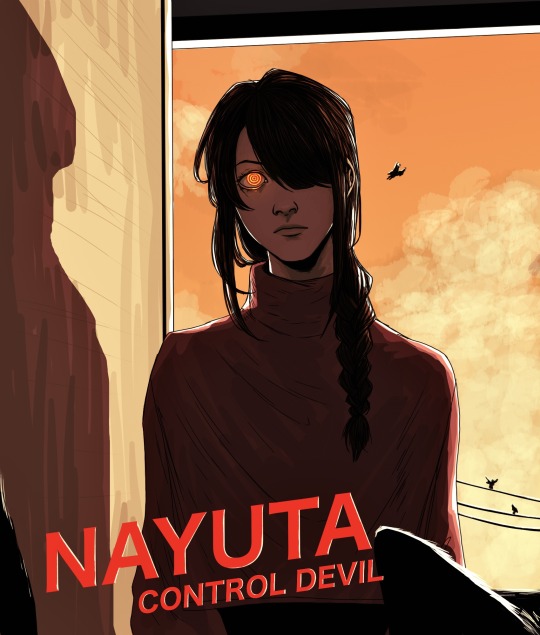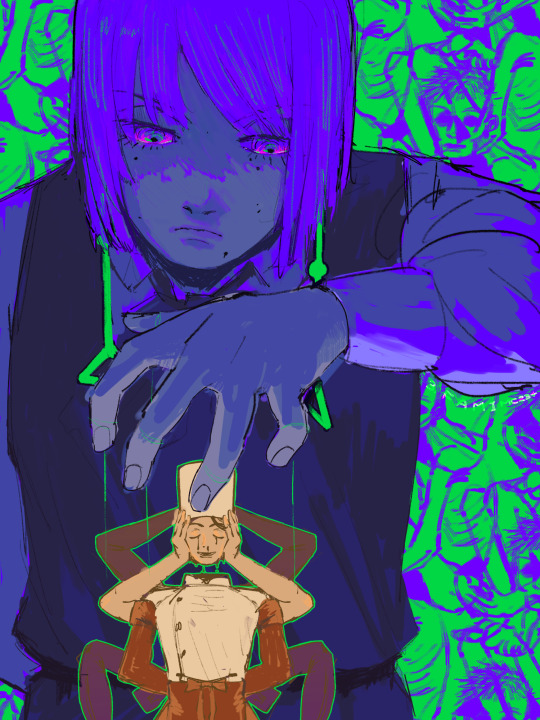Oops, this somehow became a Chainsaw man blog
Last active 2 hours ago
Don't wanna be here? Send us removal request.
Text

can't wait for fujimoto to drop the most jaw-dropping reveal about this head next week
103 notes
·
View notes
Text


Some Chainsaw Man devils
Trying to figure out Fujimoto's design style aaaaa
1K notes
·
View notes
Text




Chainsaw Man - First appearance of the Four Horsemen of the Apocalypse
2K notes
·
View notes
Text

Chainsaw Man | チェンソーマン – Chapter 123 ⊙ Hors D’oeuvres
761 notes
·
View notes
Text
what frustrates me about fandom interpretations of makima as a one note Source of evil, apart from the fact that the manga itself refutes this, is that her character haunts and ties together so much of part two that it's impossible to fully understand without understanding her.
makima isn't ever a unilateral antagonistic force. she's an agent of the institutional evil that looms over all of CSM. she's in as much a commentary on gender and performance of gender as denji is.
and fjmt in part two enacts the "haunting the narrative" trope in such an interesting manner because you see flashes of makima in every female character. you see elements of her diluted into, most visibly, the characters of asa, nayuta and fumiko.
in asa, i see makima in that yearning for connection. i see her in the way that asa herself is fundamentally unable to approach the relationship of equals that she so desperately desires, partly due to her own social awkwardness but also because of yoru's threat: everyone she gets close to turns into a weapon. the fundamental inequality to human relationships that makima is unable to overcome.
during the aquarium date, you see asa echo makima again and again in lines that evoke makima's purposing of denji. that weaponising. "i'll grant you any request / save me chainsaw man! / you don't have to think about a thing."
and her connection with denji also founds itself upon this. yoshida talks to asa about parasocial relationships -- rerendering makima's idealisation of the CSM in how asa sees denji as a love interest. asa and denji parallel each other so organically in their gendered suppression and portrusion of desire. it's a punctuation of denji's search for intimacy that's mirrored by makima's in part one. exploring how asa is different from makima is perhaps the most intriguing part of this reflection though: an example being the way asa overthinks her outfit for her date with denji while makima seamlessly models herself into an Effortless woman.
[it's not like asa borrows just from makima. for example, there are things to be said about the way she views her Body (as compared with reze and quanxi) but examining how mkm's character bleeds into asaden is quite compelling.]
nayuta being the most visible remnant of what makima was is also interesting because makima herself appears so little in nayuta beyond the surface. nayuta's role as the control devil is hinted at frequently as is her appearance resembling makima's
but her and denji's dynamic more often echoes the hayakawa family and pochita than anything else. consider: aki giving up his goal (his 'easy revenge' that he finally sees for what it is) for the sake of his family, that warmth of blood and platonic bodily intimacy that power embodies--
it's all referenced to again with nayuta and denji, in direct panel callbacks and the plot itself! nayuta is The Family that makima constructs for denji in part one to pull him along the plot she prepares. i'm thinking about how makima is an allegory for capitalism. and what the family unit means in a capitalistic structure. the propagation of an ideal that hinges on birth and descendancy, about narrative and reproduction of narrative, about how nayuta births herself from makima and denji's relationship.
and this is also why nayuta herself exerts so much control over denji in the plot, as well as why she's used as a piece to control him. in part one, family was used to create the Chainsaw Man from denji. in part two, it's used to make denji abandon the Chainsaw Man, this icon that the church and the public now take possession of. [something something alienation of the worker from the product. from the collective. from the self.]
fumiko is perhaps the hardest to pin down here because her role evolves as the fandomisation of the Chainsaw Man evolves too. in fact, as a denji fan, she represents not just makima but multiple people who see something in and want something from denji! (think of how she references reze in her highlighting how denji is just a child; how reze uses her commentary on denji to engage with her Self. it's fandomisation,,, and what is makima but Chainsaw Man's fan?)
fumiko most obviously calls back to these wants and their conceptualisation of denji in the raw sexual violence that the events in the theater scene moving into the karaoke scene embody. the undercurrent of sa that runs through p1 and p2 is brought to the forefront in this scene -- denji falling back into these cycles of abuse, him slipping into habitating the wants of others (his initial horrified expression and then his grin during the fight. his initial inner monologue and then the cut to him licking the tentacle.)
so much of CSM rests on this fandom of denji, this theme of what production and idealisation means, one you can trace through fjmt's body of work. and this fandom reaches its crescendo in p2. what's even more interesting about fumiko is her pathos under this layer. her seeing denji as denji at some level but in the end, her handling of him is so selfish. her echoing makima's uninhibited laughter at the horror of denji's situation, her predatory cruelty. denji simultaneously humanised and dehumanised through her fandom.
fjmt's characters exist as foils, as parallels and ideas. makima's character has such a stranglehold over part one and these ideas run over into part two naturally -- as a consequence of denji being a reciever of these themes, but also deliberately in fjmt evoking the Thing that is makima repetitively -- to underscore the forever re emerging structure that denji and now asa are trapped in. the same structure that makima produced and was simultaneously caged by.
558 notes
·
View notes
Text
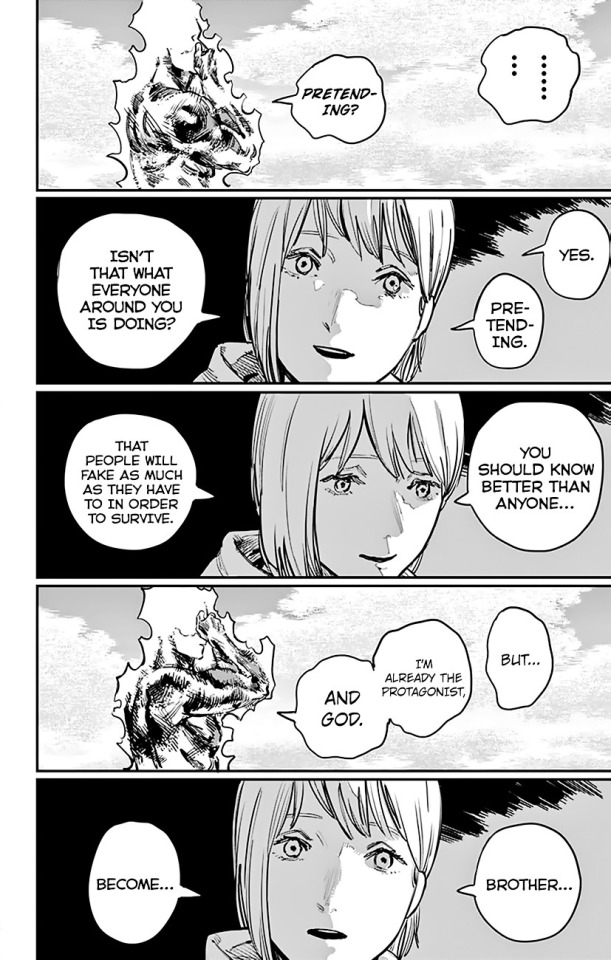
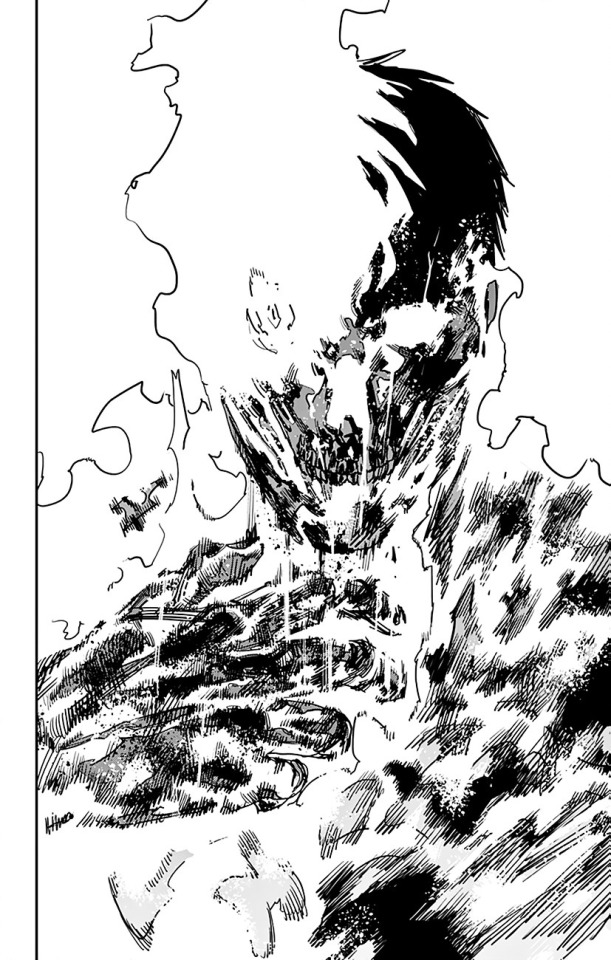
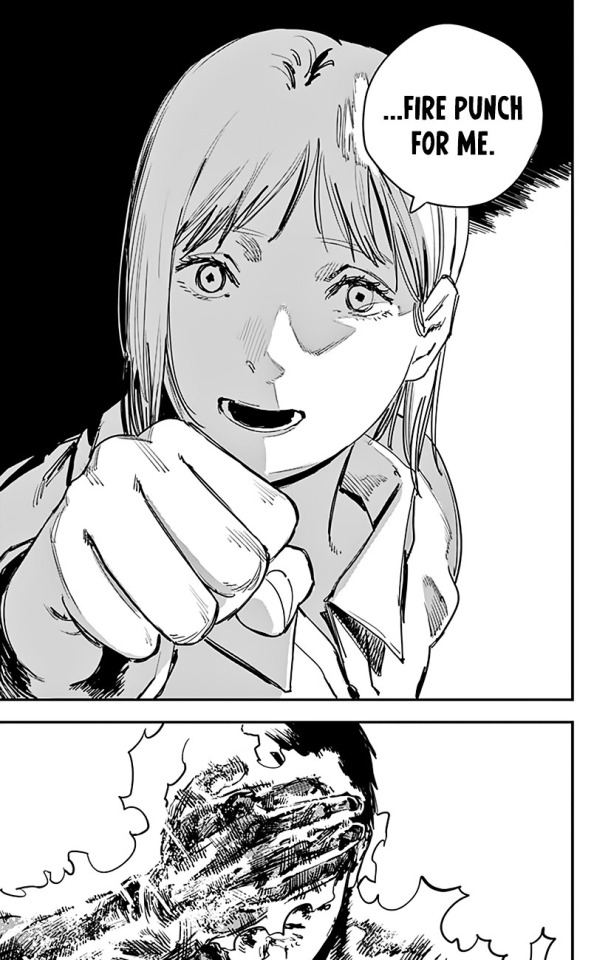
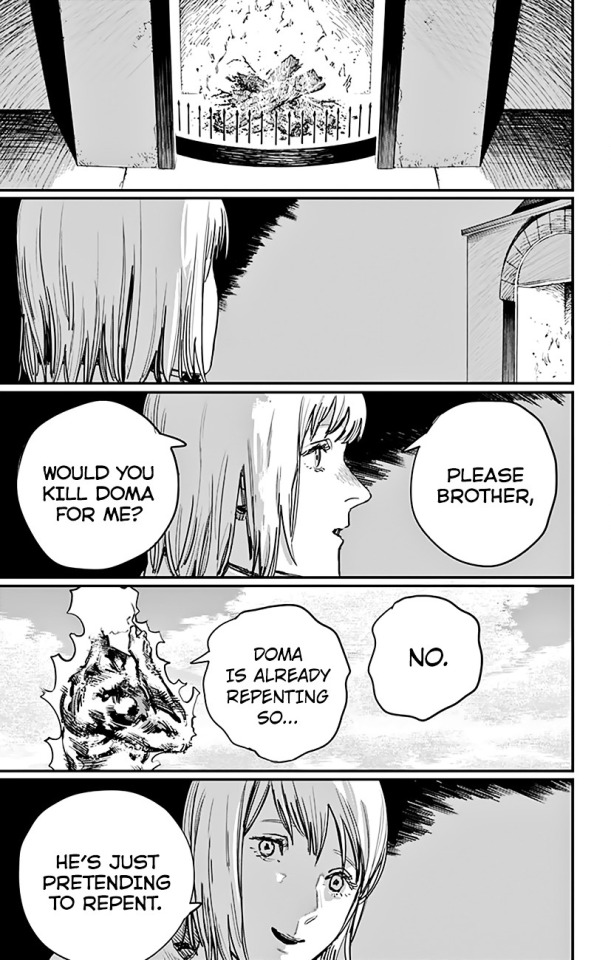
Fire Punch, chapter 45
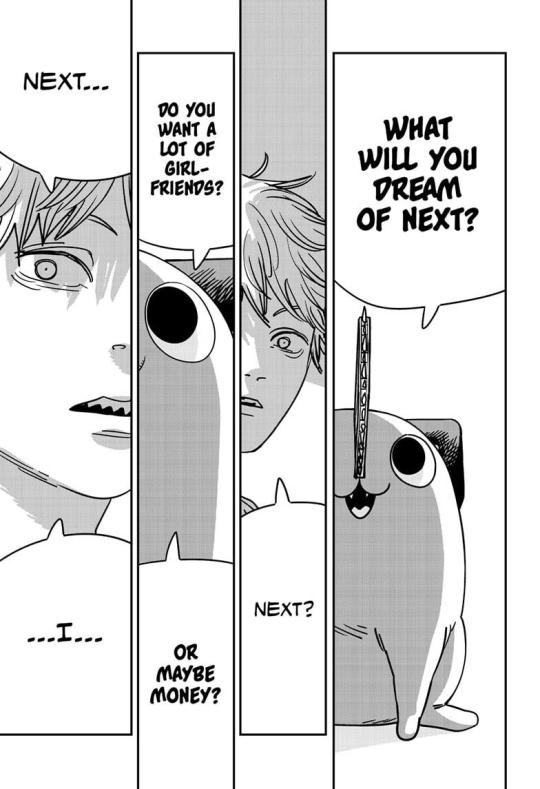


Chainsaw Man, chapter 150
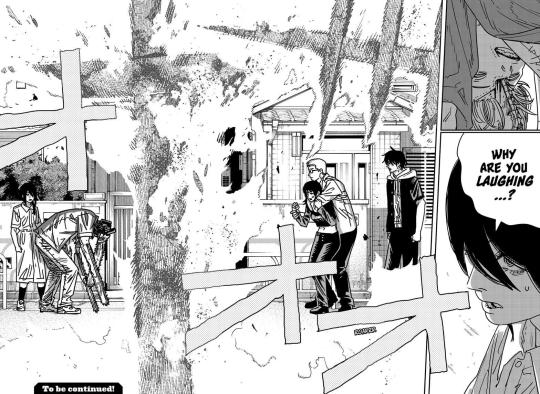

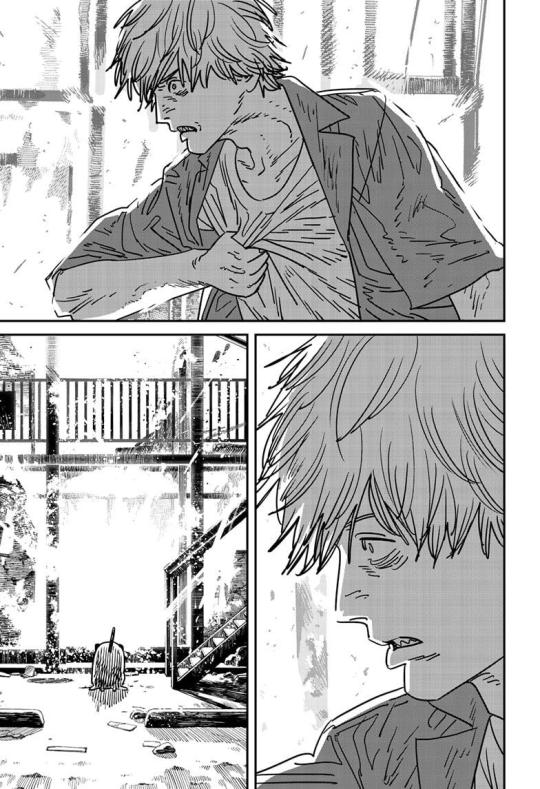
Chainsaw Man, chapter 151
315 notes
·
View notes
Text
What would happen if we killed death ?
Here we are, Chapter 150, so let's not waste any more time and get straight to the analysis.
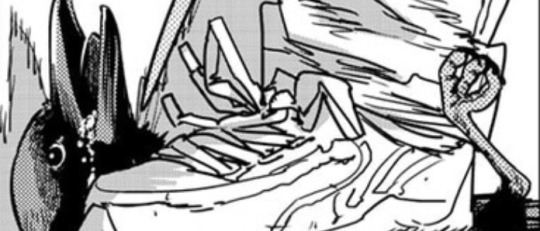
This chapter is rich, incredibly rich, both in what it says and in the way it is presented. This time I'm going to tackle the visuals directly in the first part of the chapter.
As you've probably gathered by now, this chapter deals with the evolution of Denji's dream, as the title clearly indicates.
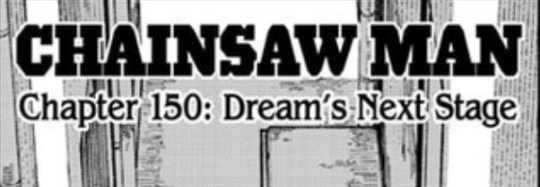
What's interesting is to see how it plays out visually. The alleyway is a visual element that has been used several times by Fujimoto to signify a period in Denji's life, his childhood.

It metaphorically represents not only an unhappy childhood and loneliness, but also the gap between a needy child ignored by society. Worse still, he is excluded. When Denji emancipates himself, the focus is on passers-by, on others. As Denji symbolically leaves the alleyway, he realises that he is now part of society. His dream of a normal life should be understood as a desire to live in a community, among others, and to make friends with them.

In other words, getting out of the alley is Denji's lifelong dream, the key to his self-fulfilment and to a certain path forward.

It's a metaphor that Fujimoto loves once again. In this illustration, for example, Aki and Power are heading towards the light while Denji is still in the shadows. Bathed in light, Aki and Power represent both a key to Denji's happiness and fulfilment, just as the light represents the end of a journey: their destiny, the end of their own lives.
This illustration is extraordinary because Denji's gaze is fixed backwards, towards the alleyway, focusing on his flaws and his past. He is unaware, because he is not looking at them, that the key to his fulfilment has already been found, that he is in the process of leaving the alleyway. What's more, even if this means the end of Power and Aki's existence, they are serene, as if they know that happiness, even without them, will await Denji.
That's my first comment, so let's move on to what's happening in terms of action and dialogue.

Nayuta focuses on ordinary life, which helps Denji realise that he has reached it. It may seem odd that Denji is only just realising this now, but he is someone who operates by the senses. Moving away from the alley visually helps him realise his emancipation, as does seeing these ordinary people.

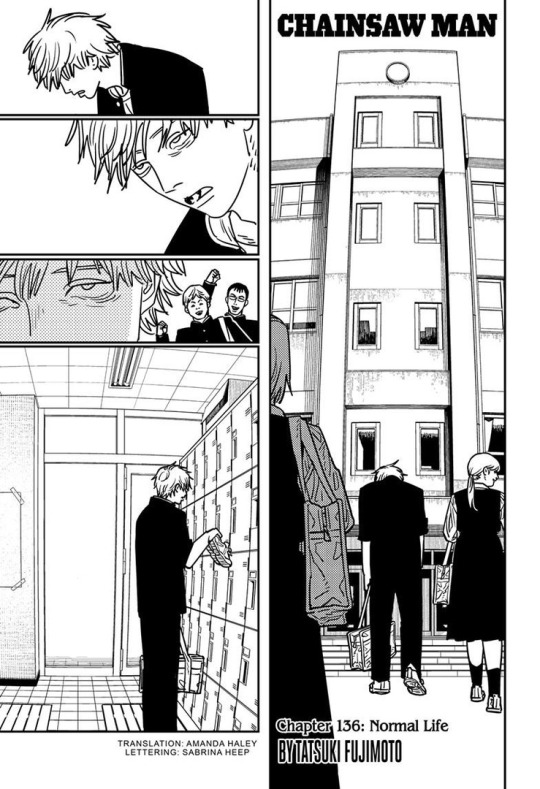
But above all, if Denji didn't entirely realise it, it's also because he wasn't happy in this ordinary life, as the last arc showed. Torn by the fact that he was no longer Chainsaw Man, Denji didn't realise that he was ordinary because he thought that was what would make him happy, and as he wasn't, he didn't think that his dream had been achieved for some time. It may sound complex, but once again it makes a lot of sense when you realise that Denji is someone who functions by sensation.
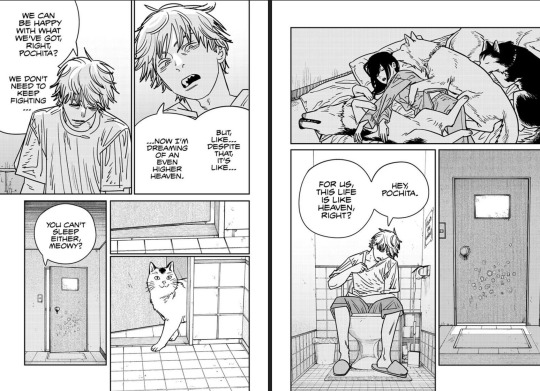
But it's even more subtle than that: Denji had realised that he was getting closer to his dream, but that wasn't why he allowed himself to dream about something else. And that's precisely where the power of this chapter lies: it's by starting to dream of something else that he reconnects with his identity, because the contract between him and Pochita is the pursuit of a dream. In other words, Denji was not only Chainsaw Man to protect Nayuta from the public hunters, he was no longer Chainsaw Man because he no longer allowed himself to dream. Until then, Chainnaw Man was an empty shell.
When Denji says he wants to become Chainsaw Man, he means he now wants to dream.


We come to the figure of the raven crushed by Denji as he runs: what does it mean?
One possible interpretation is that we don't know. I'm not saying this to clear my name, but because I think that's its real symbolism. In the West, the raven is generally a sign of bad omens, whereas in other cultures, such as Japanese or Celtic, the raven is the symbol of a god, the sun in Japan. Even if we could associate the raven with the metaphor of light coming out of the alleyway, the fact remains that it is not an animal that is appreciated or venerated in Japan, notably for the fact that it is a vulture that picks through rubbish.
It's this ambiguity that the raven represents, something that can't be pinned down. It's interesting, because by trampling on it, Denji turns to another dream, is it a good omen or a bad one? No one knows whether claiming to be Chainsaw Man will help Denji find happiness.

That would be one possible interpretation. But for the sake of completeness, there is one last one.
When I say that symbolism is hard to establish, it's only when I refute an obvious one. Let me explain: whether it's Bucky and his death, Yoru and Asa's death, the birds and Yuko being killed by Fake!CSM, and finally that raven. It's obvious that not only the raven but the bird in general represents death but also the end of a period, an era, a cycle.

Not only do the birds mark the end of one cycle, they also signal the beginning of a new one. Bucky's death opens Part 2, Yoru marks the beginning of Asa's second life, and Yuko's death ushers in the arrival of the most mysterious character in Part 2: Fake!CSM. The Raven marks the beginning of a new dream.
I think we need to be more subtle in this analysis and see it through to the end. Asa and Denji both do the same thing, they either crush birds or they give death to death.
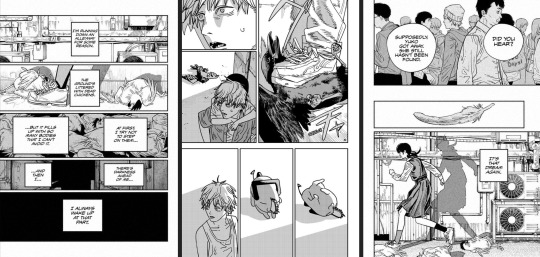
It seems impossible but just as the bird that is supposed to fly in the skies is rarely found under our feet to be crushed. Asa and Denji are the two champions, the two candidates to prevent Death, and little by little the birds mark the cogs in a mechanism that is being put in place: the confrontation with Death.
My various interpretations can add up, and when they do, they lead to one question: when we give death to death, what happens? Is it necessarily a bad thing ?
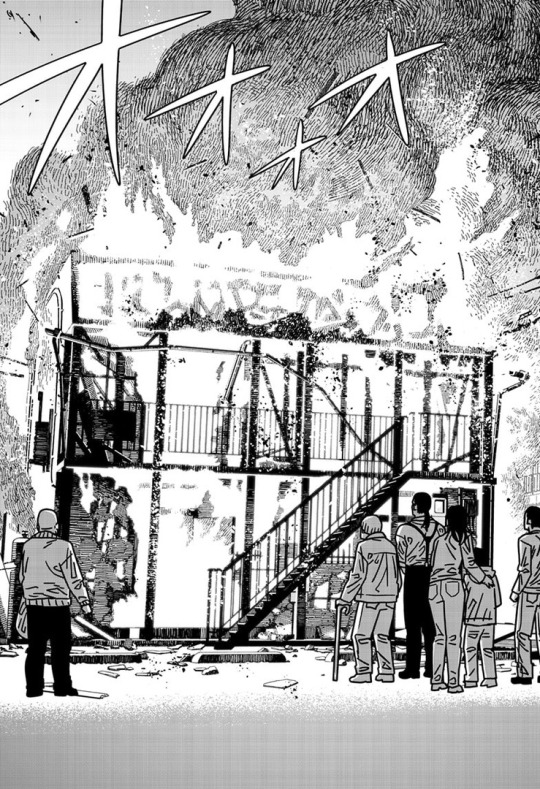
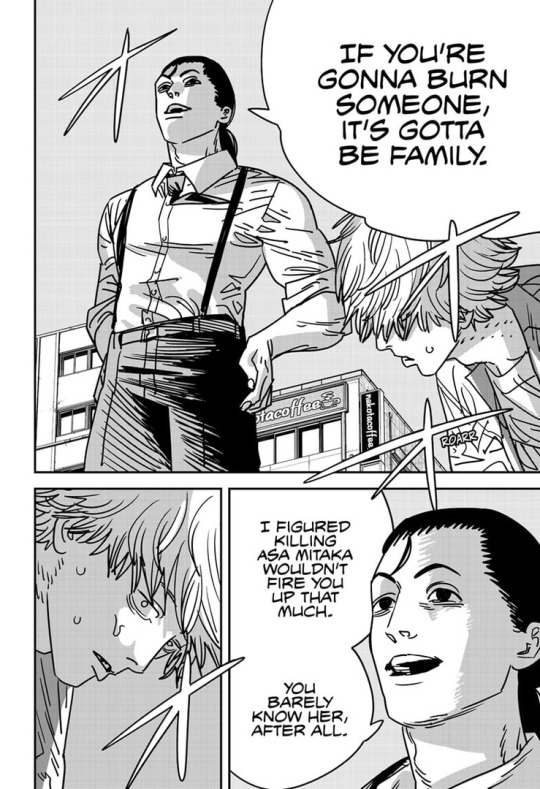
The fact that the birds symbolise a link with death is correlated with the fact that Denji loses his family and his dogs when his flat burns down. The destruction of his home represents the erasure of Denji's landmarks, what he had built up, returning to the cause of departure, since we are at the beginning of a new era, a new cycle.
The relationship with death is correlated by Barem, who not only intends to fight it but also sees it as a common denominator for all species.
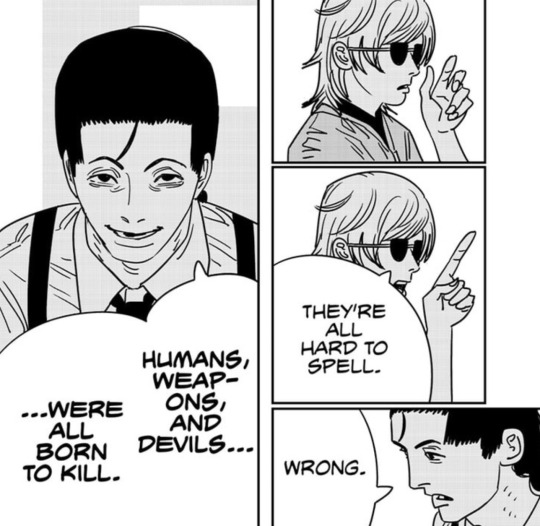
I love the play on words that the flamethrower hybrid introduces: "I figure killing Asa wouldn't fire you up that much", it really supports Barem's desire to arouse Denji and get him to react.
But all that aside, there are other things to relate. Not least with our other protagonist: Asa.
To return to the metaphor of the alley, visually and symbolically, she's the one who joined Denji in the alley. She's not just a symbol of Denji's step towards others, but also a symbol of others' step towards him.
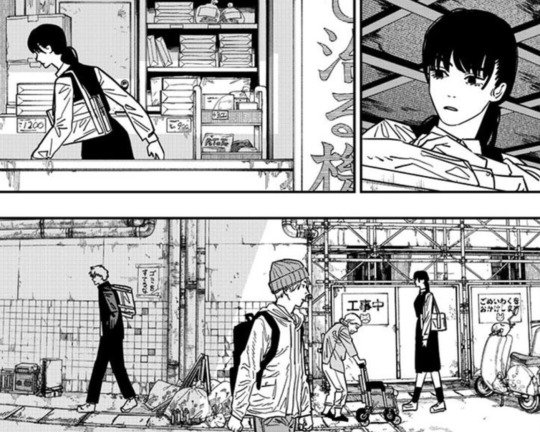
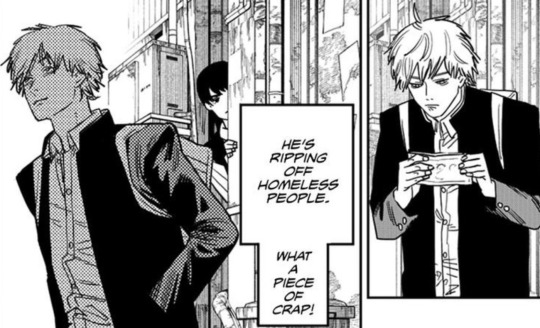
Fujimoto encourages us to reread the chapters using the key vectors of the dog and the cat.
This line is the centrepiece.

Not only does Barem support the death once again of Denji's family, his dogs and his cat, but it's much more subtle than that. They are the key to a love that is not only universal, but also the key to Asa and Denji's happiness, and to their ability to bond with other species. When Denji wanted to save Asa from the falling devil, he told her straight away to think of cats and dogs.

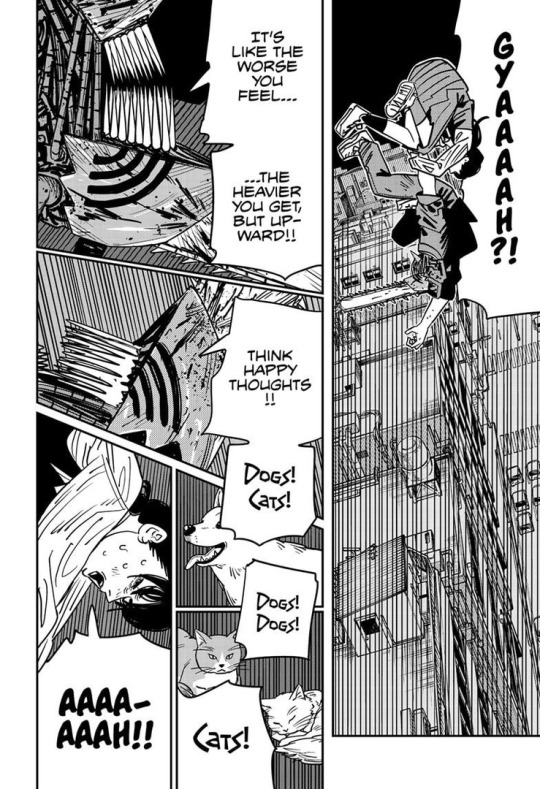
They are also a symbol of progress, Asa bonding with her cat after the death of her mother, while Denji bonds with Pochita after the death of his father.
They are also what unites the two protagonists of Chainsaw Man: a cat with Asa and a dog with Denji. Just as Fujimoto likes to emphasise the influence they have on each other, whether it's Asa who places Denji between the criminal and the cat or how Yoru will behave like a dog because of Nayuta.

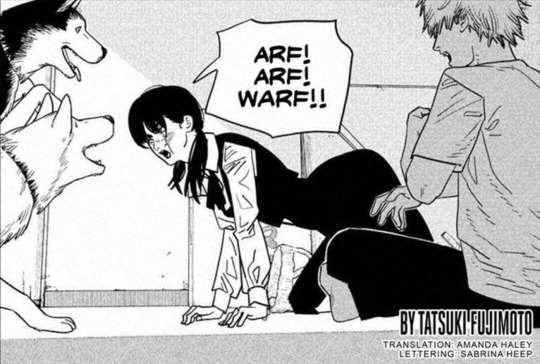
So what does Barem's line clearly mean? What I find incredible is that every time Barem tries to put Denji against the wall, he always unconsciously provides an element of the answer.
At their first meeting in chapter 140: Barem tries to present Denji with a dilemma. Asa Mitaka or Chainsaw Man? The answer is unconsciously found in the two fingers he plunges into Denji's nose: both.
Here again, Barem thinks he has Denji pegged, it's not Asa that matters to him but his dogs and cat. But note the plural, Denji only has one cat, Meowy. Now we make the connection: Asa represents the cat. She's also important to Denji.
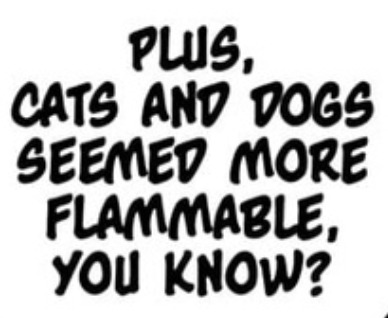
If you're not convinced by Barem's unconscious response, then here again you can see a parasitic gesture in the fact that he knocks Denji down. Who else always falls at the wrong time? Who fell when their family was also dying? Well, yes. Barem's only point here is that even if Asa and Denji don't know each other very well, they don't really need to, given their similarities.


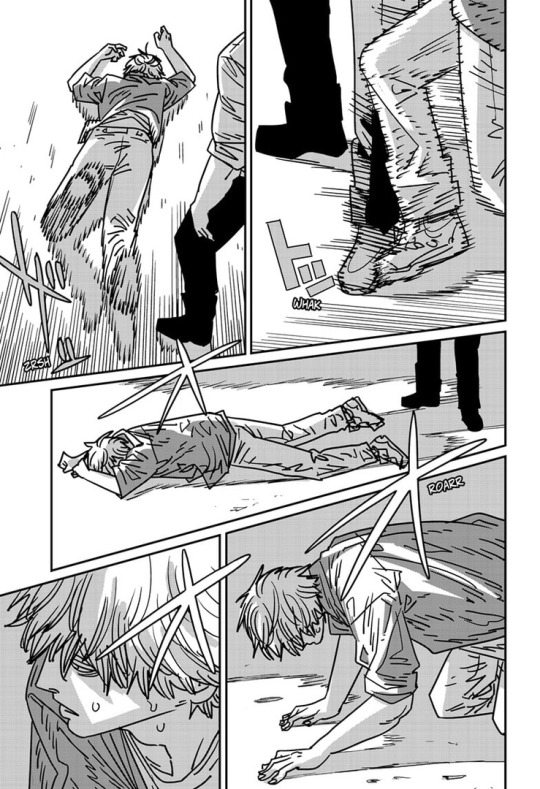
Once again, Barem thinks he's cornering Denji when he doesn't realise that he's just included Asa in what he's saying. Once again this is symbolic writing, with elements of foreshadowing and denouement of the characters subtly placed in Barem's lines. Barem likes to make prophetic announcements, as he is also a believer, but his message escapes him because he is not aware of the work in which he finds himself.
But that doesn't help us to understand what happens when we kill death ?
The characters can't guess at the omens that lie ahead. Just as their own message eludes them.
The only thing we know for sure that these birds are announcing is the end of an era and a new era.

The answer is so obvious that it escapes us. We have seen the resemblance between these two protagonists, their families, their losses, the destruction of their homes, their landmarks. We could say that this would be mourning.
But moving on despite the end of all these cycles, without knowing what lies ahead. Isn't that just growing up?
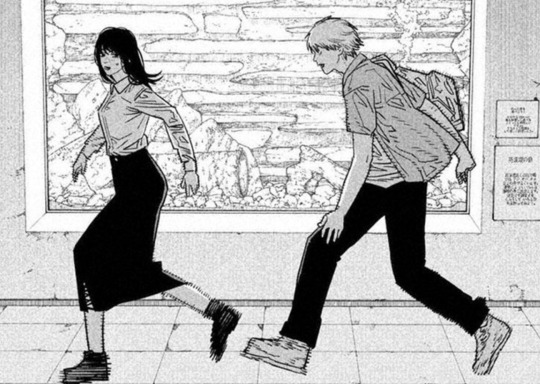
332 notes
·
View notes
Text

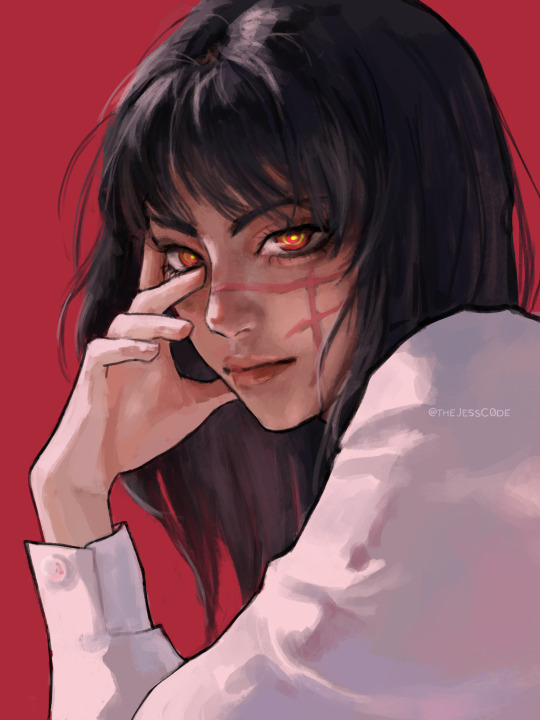
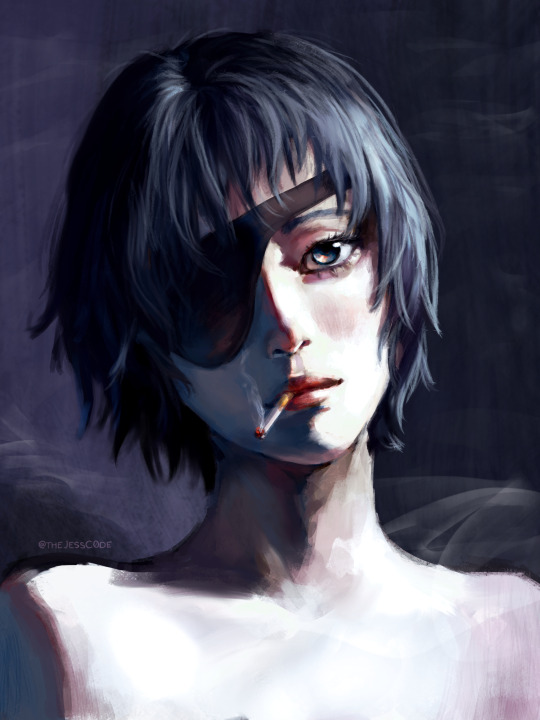
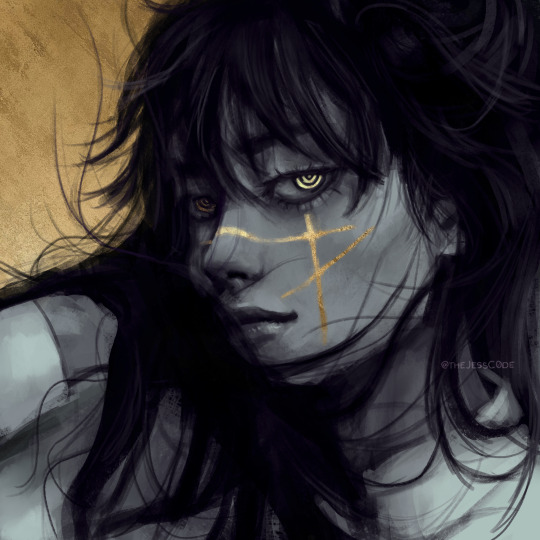
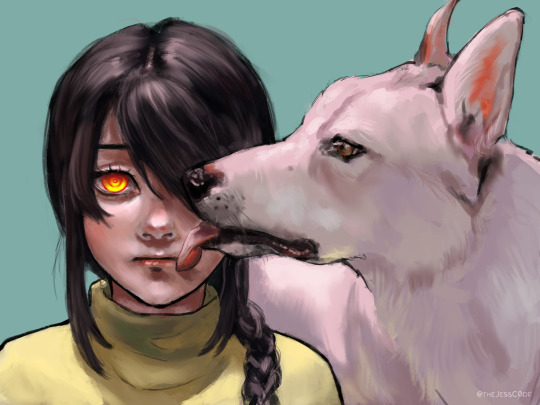

my favorite csm fanarts that I've done so far!
3K notes
·
View notes
Text
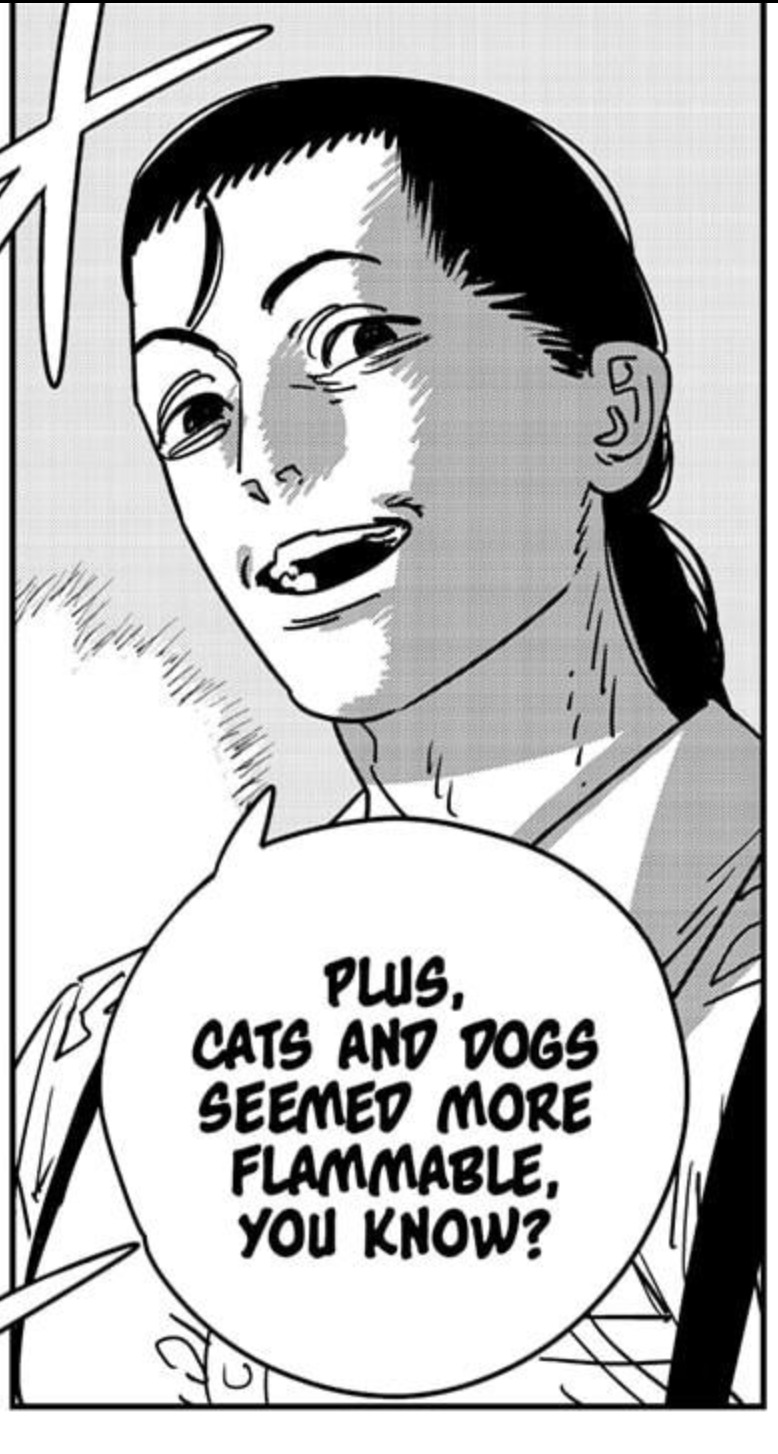
DIE. DIE DIE DIE DIE DIE DIE DIE DIE DIE DIE DIE DIE DIE DIE DIE DIE DIE DIE DIE DIE DIE DIE DIE DIE DIE DIE DIE DIE DIE DIE DIE DIE DIE DIE DIE DIE DIE DIE DIE DIE DIE DIE DIE DIE DIE DIE DIE DIE DIE DIE DIE DIE DIE DIE DIE DIE DIE DIE DIE DIE DIE DIE DIE DIE DIE DIE DIE DIE DIE DIE DIE DIE DIE DIE DIE DIE DIE DIE DIE DIE
This fucking guy. THIS. FUCKING. GUY. Get John Wick. Get Lucy. Get every animal wellfare group in the cosmos, people. What Saw trap do you want to stick him in? Me, I'm thinking of the Brazen Bull trap from Saw 3D. It involves fire, it's excruciating, and he deserves it far more than the victim in the movie.
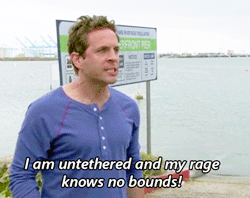
57 notes
·
View notes


